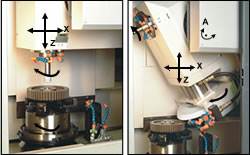Grinding
Vertical Grinding Has Advantages
In vertical grinding, the workpiece is held upright in a rotary chuck with the grinding spindle overhead. This configuration can improve roundness, facilitate single-setup processing and prolong the life of the machine. Loading and unloading may gets easier, too. Workpieces with relatively large diameters and short lengths benefit the most from vertical grinding.
Read MoreDressed For Success
Here are some tips for getting the best performance from a grinding wheel.
Read More





.jpg;maxWidth=300;quality=90)



